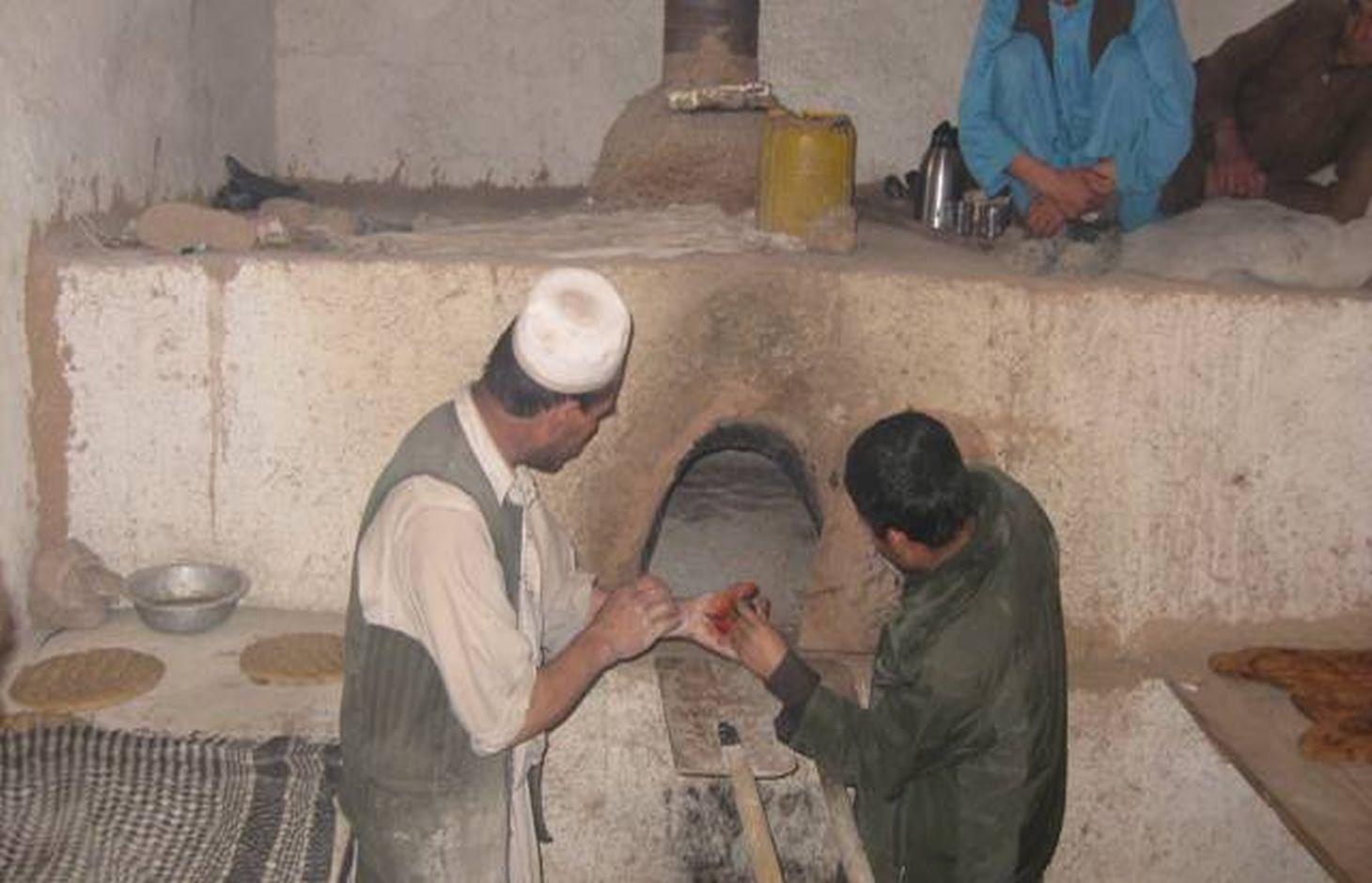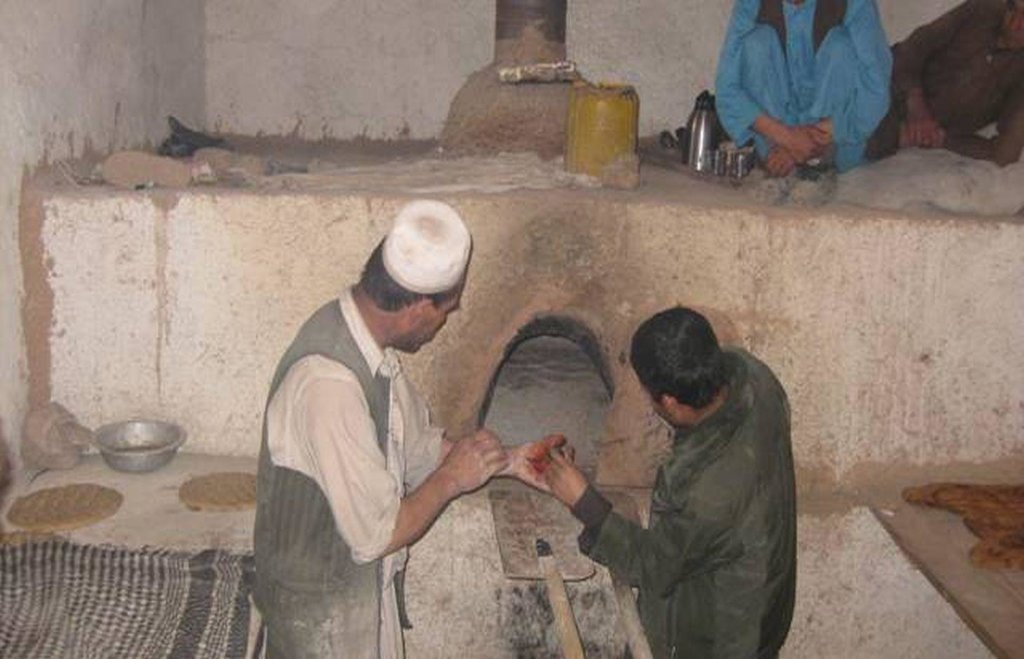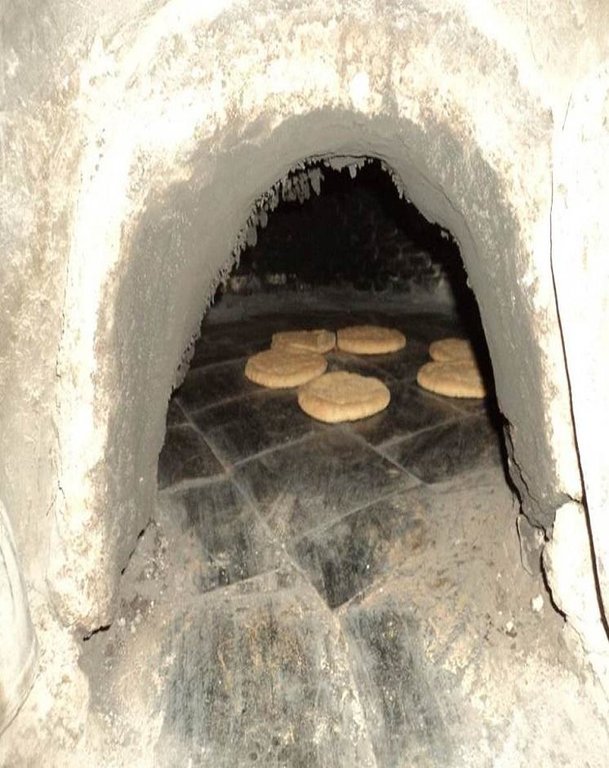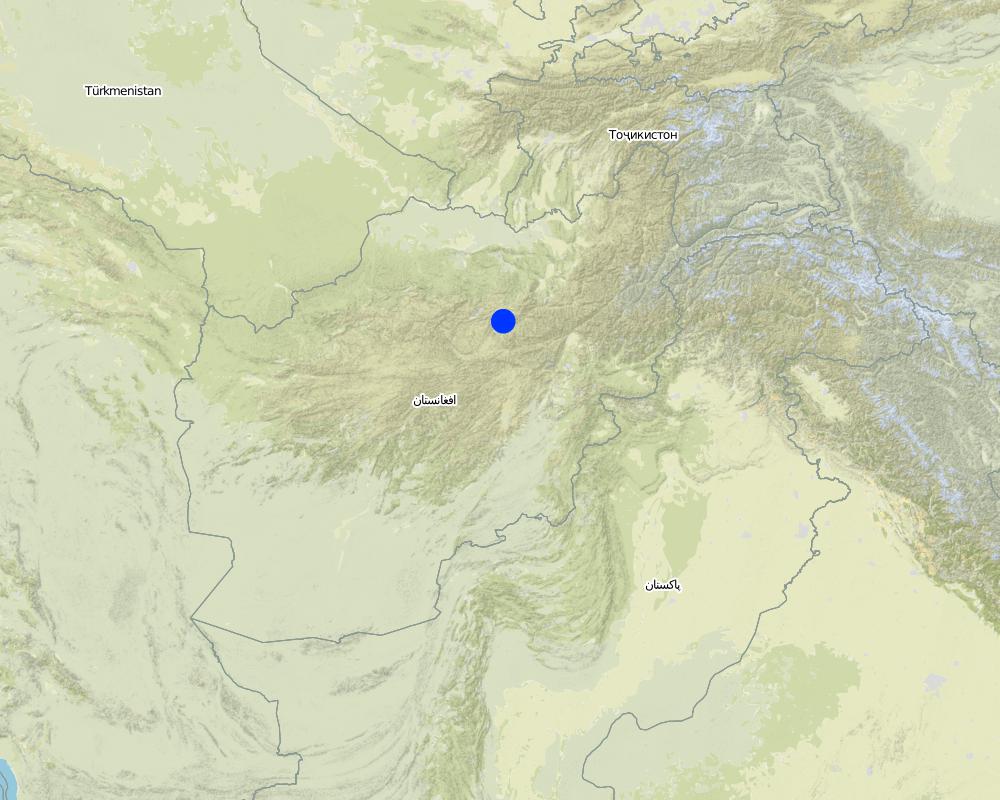Community bakery [Afghanistan]
- Creation:
- Update:
- Compiler: Aqila Haidery
- Editor: –
- Reviewers: Deborah Niggli, Joana Eichenberger
Dash Nanboe (Dari)
technologies_1718 - Afghanistan
View sections
Expand all Collapse all1. General information
1.2 Contact details of resource persons and institutions involved in the assessment and documentation of the Technology
Key resource person(s)
SLM specialist:
SLM specialist:
Homayoun Ashraf
HELVETAS Swiss Intercooperation
Afghanistan
SLM specialist:
Ahmad Ali Sediqi
HELVETAS Swiss Intercooperation
Afghanistan
1.3 Conditions regarding the use of data documented through WOCAT
The compiler and key resource person(s) accept the conditions regarding the use of data documented through WOCAT:
Yes
1.4 Declaration on sustainability of the described Technology
Is the Technology described here problematic with regard to land degradation, so that it cannot be declared a sustainable land management technology?
No
2. Description of the SLM Technology
2.1 Short description of the Technology
Definition of the Technology:
A sustainable option for bread baking and reducing shrub consumption
2.2 Detailed description of the Technology
Description:
Thirty six community bakeries were constructed in Kahmard from 2009-2012 for reducing shrub consumption. Rural communities normally bake bread at home using tandoors made from clay and fired by shrubs, wood and coal. Bread baking is a demanding task. Men and boys climb mountains to collect shrubs, putting themselves at risk, and women spend 1-2 hours/day for preparing dough, firing the oven and baking bread. Shrub cutting causes upland degradation leading to flash floods in the valleys.
In Saighan, district adjoining Kahmard, a survey showed that one household uses 81 donkey load shrubs annually, and minimum 50 donkey loads are used for baking bread. Kahmard has a similar situation. To address this, HELVETAS Swiss Intercooperation is supporting an integrated watershed management in Kahmard since 2008 with support from the Swiss Re and Swiss Agency for Development and Cooperation (SDC). The approach comprises other technological and organisational measures where structural and vegetative are applied, combined with grazing and shrub cutting control. To complement re-greening efforts, energy efficient community bakeries were promoted.
Households using community bakeries reported a decrease in shrub consumption by 50-80%, which contributes to greener watersheds. The other benefits include more time for women, boys and girls for other preferred activities, like attending school, literacy classes, vocational trainings, embroidery, etc. Families also save money (minimum US$ 10/month) as they have to purchase less shrubs for baking purpose. In Kahmard, one donkey load shrub costs about US$ 6. Bakers, assistant bakers, masons and workers are employed and bakeries serve as a place for social networking. By contributing to greener watersheds, the bakeries help to reduce flash flood risks. In recent months, running the bakeries has become a challenge as the coal mines in Kahmard have been contracted to a Chinese firm. As a consequence, people are not getting coal easily. Due to coal shortages, several bakeries have stopped functioning. People are looking towards the government authorities to solve this issue as soon as possible. Many households have gone back to shrub cutting and a community assets with proven benefits for the people but environment remains underutilized.
The participating community development councils or CDCs allocate land for bakery. One bakery costs about US$ 4640, with 25% community contribution during construction. It takes about 5 weeks for constructing one bakery if there are no obstacles. About US$ 7300/year is spent on operation and maintenance by the people. One baker and 1-2 assistants are employed for daily bakery operations. The dash or oven is prepared from a mixture of clay and sheep hair and fired by coal. About 1-3 bags are required per day. If mosaic tiles are used, about 1 bag per day is used for heating. The factors influencing the success of community bakeries include access to coal, good quality and low price of coal, on time payment and proper management of bakery funds. The clients bring dough from home and pay about US$ 0.042 (2 Afghani) per bread to the baker or about US$ 6.6/month.
Community bakeries were constructed in the Kahmard district in the valley bottoms where the people reside. The land for community bakeries normally belongs to the community, but where suitable common land is not available, individuals have also donated their private lands for the common cause.
Community bakeries are located at an altitude of about 1700-1800 m above mean sea level. The district receives up to 400 mm rainfall in a good year. In the valley bottom, there are crop growing seasons, the main is from March to July. The land users rely mainly on agriculture for their livelihoods as employment opportunities in the district are very few. Kahmard district has a population density of about 30 person/sq. km. About 50% of the rural population in Kahmard falls under poor category, 40% are medium rich and 10% rich.
2.3 Photos of the Technology
2.5 Country/ region/ locations where the Technology has been applied and which are covered by this assessment
Country:
Afghanistan
Region/ State/ Province:
Bamyan Province
Further specification of location:
Kahmard district
Specify the spread of the Technology:
- evenly spread over an area
If precise area is not known, indicate approximate area covered:
- < 0.1 km2 (10 ha)
Comments:
Each bakery has an area of about 58 sq. m, and 25 bakeries have been constructed so far in Kahmard district with HELVETAS Swiss Intercooperation support and financial contributions from the Swiss Agency for Development and Cooperation (SDC).
Map
×2.6 Date of implementation
If precise year is not known, indicate approximate date:
- less than 10 years ago (recently)
2.7 Introduction of the Technology
Specify how the Technology was introduced:
- through projects/ external interventions
Comments (type of project, etc.):
The first community bakery in Kahmard district was constructed in 2009 with HELVETAS Swiss Intercooperation support. Since then, 25 bakeries have been constructed as a complementary watershed management technology.
3. Classification of the SLM Technology
3.2 Current land use type(s) where the Technology is applied

Settlements, infrastructure
- Community bakeries

Unproductive land
Specify:
Wastelands, deserts, glaciers, swamps, recreation areas, etc before Technology, settlements, infrastructure networks afterwards.
Comments:
Major land use problems (compiler’s opinion): Severe flash floods due to degradation of upland watersheds as a result of overgrazing, shrub uprooting, ploughing and recurring droughts. There is a lack of organizational capacities for sustainable management of land and water resources.
Major land use problems (land users’ perception): Severe flash floods due to watershed degradation resulting in destruction of property and life. Lack of knowledge about disaster risk mitigation. Lack of alternatives to fuel wood, especially for bread baking and house warming.
Future (final) land use (after implementation of SLM Technology): Other: Os: Settlements, infrastructure networks
Constraints of settlement / urban: Some areas are not fully utilized. Some are vulnerable to flash floods.
Number of growing seasons per year: 2
Longest growing period in days: 150, Longest growing period from month to month: March to July, Second longest growing period in days: 90, Second longest growing period from month to month: August to October
3.3 Has land use changed due to the implementation of the Technology?

Unproductive land
Specify:
Wastelands, deserts, glaciers, swamps, recreation areas, etc before Technology, settlements, infrastructure networks afterwards.
3.5 SLM group to which the Technology belongs
- pastoralism and grazing land management
- improved ground/ vegetation cover
3.6 SLM measures comprising the Technology

structural measures
- S11: Others
3.7 Main types of land degradation addressed by the Technology

soil erosion by water
- Wt: loss of topsoil/ surface erosion
- Wg: gully erosion/ gullying

biological degradation
- Bc: reduction of vegetation cover
Comments:
Main causes of degradation: over-exploitation of vegetation for domestic use (extraction of shrubs for fuelwood), overgrazing (Overgrazing by sheep and goats), disturbance of water cycle (infiltration / runoff) (Due to biological degradation), droughts (Recurring droughts slow down vegetation recovery), land tenure (If it was private land, degradation extent would have been much less), governance / institutional (There is no legal and institutional set up for community based natural resource management)
Secondary causes of degradation: deforestation / removal of natural vegetation (incl. forest fires) (Removal of Juniper trees during war period), other natural causes (avalanches, volcanic eruptions, mud flows, highly susceptible natural resources, extreme topography, etc.) specify (Some grazed areas are very steep), population pressure (Due to increasing population, there is increasing pressure on natural resources), poverty / wealth (People depend on livestock. There is lack of off-farm employment opportunities), war and conflicts (During war, traditional NRM systems also collapsed)
3.8 Prevention, reduction, or restoration of land degradation
Specify the goal of the Technology with regard to land degradation:
- reduce land degradation
- restore/ rehabilitate severely degraded land
4. Technical specifications, implementation activities, inputs, and costs
4.1 Technical drawing of the Technology
Technical specifications (related to technical drawing):
A detailed technical drawing (long section) of a community bakery in Kahmard district supported by HELVETAS Swiss Intercoop-eration with the dome shaped oven or dash.
Location: Nowjoy Kona Qala. Kahmard district/Bamyan province
Date: 04/2009
Technical knowledge required for field staff / advisors: moderate (The community bakery was designed by Engineers of HELVETAS Swiss Intercooperation)
Technical knowledge required for land users: high (Construction of dash requires high technical knowledge. There are however some very skilled people in the community who know the art of making dash.)
Main technical functions: improvement of ground cover, increase of infiltration, Reduces people's dependency on shrubs, which are extracted from the upland watersheds
Structural measure: Community Bakery
Height of bunds/banks/others (m): 4.75
Width of bunds/banks/others (m): 7.45
Length of bunds/banks/others (m): 12.5
Construction material (earth): Soil/clay/sand
Construction material (stone): stones for foundation/bricks (sun dried)
Construction material (wood): Poles for roof beams, doors, windows
Construction material (concrete): cement, gypsum
Construction material (other): hair for dash
Author:
Eng. Rohullah Zahedi, HELVETAS Swiss Intercooperation, Afghanistan
4.2 General information regarding the calculation of inputs and costs
other/ national currency (specify):
Afghani
If relevant, indicate exchange rate from USD to local currency (e.g. 1 USD = 79.9 Brazilian Real): 1 USD =:
50.0
Indicate average wage cost of hired labour per day:
5.00
4.3 Establishment activities
| Activity | Timing (season) | |
|---|---|---|
| 1. | Construction of community bakery as per technical design and based on feasibility study | Five months |
4.4 Costs and inputs needed for establishment
| Specify input | Unit | Quantity | Costs per Unit | Total costs per input | % of costs borne by land users | |
|---|---|---|---|---|---|---|
| Labour | 1.0 | 1223.0 | 1223.0 | 10.0 | ||
| Equipment | Tools | 1.0 | 60.0 | 60.0 | 100.0 | |
| Construction material | Sand, soil, cement, gypsum, br | 1.0 | 3356.0 | 3356.0 | 30.0 | |
| Total costs for establishment of the Technology | 4639.0 | |||||
| Total costs for establishment of the Technology in USD | 92.78 | |||||
Comments:
Duration of establishment phase: 1.5 month(s)
4.5 Maintenance/ recurrent activities
| Activity | Timing/ frequency | |
|---|---|---|
| 1. | Bakery operation (Baker and Assistant Baker salaries) | Year round |
| 2. | Roof plastering with clay and straw | Once before winter |
| 3. | Baking bread | Year round |
| 4. | Dash firing and heating | year round |
| 5. | Fire ignition | Year round |
4.6 Costs and inputs needed for maintenance/ recurrent activities (per year)
| Specify input | Unit | Quantity | Costs per Unit | Total costs per input | % of costs borne by land users | |
|---|---|---|---|---|---|---|
| Labour | 1.0 | 3600.0 | 3600.0 | 100.0 | ||
| Construction material | Roof plastering mud and straw | 1.0 | 38.5 | 38.5 | 100.0 | |
| Construction material | Coal | 1.0 | 3650.0 | 3650.0 | 100.0 | |
| Construction material | Tyre | 1.0 | 300.0 | 300.0 | 100.0 | |
| Construction material | Dash shovel | 1.0 | 10.0 | 10.0 | 100.0 | |
| Total costs for maintenance of the Technology | 7598.5 | |||||
| Total costs for maintenance of the Technology in USD | 151.97 | |||||
Comments:
Machinery/ tools: Sand, Soil, cement, gypsum, bricks, stones, gravel, straw, plastic, clay, hair, wooden door, timber for beams, glass, paint, gutter pipes. Ventilation pipes
The costs in 2.6.1. relate to the construction, operation and maintenance of one community bakery. The estimates are based on the Bills of Quantity prepared in 2009.
4.7 Most important factors affecting the costs
Describe the most determinate factors affecting the costs:
Most of the expenses for construction work is on equipment and materials like shovels, pick axe, wheel barrow, wooden doors, timber beams, window, concrete bricks, and sun dried bricks. In terms of recurrent costs, most spending is on coal and on the salaries of the baker and assistant bakers.
5. Natural and human environment
5.1 Climate
Annual rainfall
- < 250 mm
- 251-500 mm
- 501-750 mm
- 751-1,000 mm
- 1,001-1,500 mm
- 1,501-2,000 mm
- 2,001-3,000 mm
- 3,001-4,000 mm
- > 4,000 mm
Agro-climatic zone
- semi-arid
Thermal climate class: temperate. The minimum temperature in Kahmard district can be up to -70°C.
5.2 Topography
Slopes on average:
- flat (0-2%)
- gentle (3-5%)
- moderate (6-10%)
- rolling (11-15%)
- hilly (16-30%)
- steep (31-60%)
- very steep (>60%)
Landforms:
- plateau/plains
- ridges
- mountain slopes
- hill slopes
- footslopes
- valley floors
Altitudinal zone:
- 0-100 m a.s.l.
- 101-500 m a.s.l.
- 501-1,000 m a.s.l.
- 1,001-1,500 m a.s.l.
- 1,501-2,000 m a.s.l.
- 2,001-2,500 m a.s.l.
- 2,501-3,000 m a.s.l.
- 3,001-4,000 m a.s.l.
- > 4,000 m a.s.l.
5.3 Soils
Soil depth on average:
- very shallow (0-20 cm)
- shallow (21-50 cm)
- moderately deep (51-80 cm)
- deep (81-120 cm)
- very deep (> 120 cm)
Soil texture (topsoil):
- medium (loamy, silty)
Soil texture (> 20 cm below surface):
- medium (loamy, silty)
Topsoil organic matter:
- low (<1%)
5.4 Water availability and quality
Ground water table:
5-50 m
Availability of surface water:
good
Water quality (untreated):
good drinking water
Comments and further specifications on water quality and quantity:
When the water is fetched from wells or natural springs the water is good drinking water, otherwise it is poor drinking water (surface water, must be treated before consumption)
5.5 Biodiversity
Species diversity:
- low
5.6 Characteristics of land users applying the Technology
Off-farm income:
- 10-50% of all income
Relative level of wealth:
- poor
- average
Individuals or groups:
- groups/ community
Gender:
- men
Indicate other relevant characteristics of the land users:
Land users applying the Technology are mainly common / average land users
Difference in the involvement of women and men: Men are mostly involved in the construction and operation of the bakeries. However, in some areas women and girls bring pasta to the bakery for bread baking. Women's support for community bakeries is strong as they benefit directly .
Population density: 10-50 persons/km2
Annual population growth: 2% - 3%
10% of the land users are very rich.
40% of the land users are average wealthy.
50% of the land users are poor.
Off-farm income specification: Due to small land holding size, there is not enough income from the farmlands to support large families. Therefore, people rely on seasonal work opportunities either within the district or their communities or migrate to Afghan cities or neighboring countries for work. Some people work in coal mines which are present in the district.
5.7 Average area of land used by land users applying the Technology
- < 0.5 ha
- 0.5-1 ha
- 1-2 ha
- 2-5 ha
- 5-15 ha
- 15-50 ha
- 50-100 ha
- 100-500 ha
- 500-1,000 ha
- 1,000-10,000 ha
- > 10,000 ha
Is this considered small-, medium- or large-scale (referring to local context)?
- medium-scale
5.8 Land ownership, land use rights, and water use rights
Land ownership:
- communal/ village
- individual, titled
Land use rights:
- communal (organized)
Water use rights:
- communal (organized)
Comments:
Mostly, the land used for community bakeries belongs to the community. In case suitable land is not available, the community development council members and village elders motivate individuals to spare their land for the common cause.
5.9 Access to services and infrastructure
health:
- poor
- moderate
- good
education:
- poor
- moderate
- good
technical assistance:
- poor
- moderate
- good
employment (e.g. off-farm):
- poor
- moderate
- good
markets:
- poor
- moderate
- good
energy:
- poor
- moderate
- good
roads and transport:
- poor
- moderate
- good
drinking water and sanitation:
- poor
- moderate
- good
financial services:
- poor
- moderate
- good
6. Impacts and concluding statements
6.1 On-site impacts the Technology has shown
Socio-economic impacts
Production
wood production
Comments/ specify:
This is due to less shrub extraction in the watersheds
energy generation
Income and costs
diversity of income sources
Comments/ specify:
Some women have more time and can take part in off-farm income generation activities. e.g. embroidery.
Other socio-economic impacts
Air pollution
Comments/ specify:
Due to burning of coal.
Loss of income for shrub collectors
Comments/ specify:
Less demand for shrubs for fire wood.
Socio-cultural impacts
food security/ self-sufficiency
Comments/ specify:
Due to more savings, people can buy more food and reduce their food gaps.
health situation
Comments/ specify:
Less exposure to smoke and heat.
cultural opportunities
Comments/ specify:
More opportunities for social networking for men and women.
recreational opportunities
Comments/ specify:
Especially for women as they have more time.
community institutions
Comments/ specify:
People cooperate with each other for running the bakeries. There are less conflicts over bread baking within the households. There is also more social networking as people meet more often at the bakeries when they bring dough.
SLM/ land degradation knowledge
Comments/ specify:
People understand well the linkage between community bakeries, watershed management and flash flood risk mitigation.
conflict mitigation
Comments/ specify:
Especially members of a family over bread baking or shrub collection.
Ecological impacts
Water cycle/ runoff
surface runoff
Comments/ specify:
Due to better vegetation cover in the watersheds.
Soil
soil cover
Comments/ specify:
Due to more shrubs in the watersheds.
Biodiversity: vegetation, animals
biomass/ above ground C
Comments/ specify:
Due to increased shrub cover.
Other ecological impacts
energy generation (eg hydro, bio)
Comments/ specify:
Use of coal which is plenty available in the district due to presence of coal mines.
6.2 Off-site impacts the Technology has shown
downstream flooding
Comments/ specify:
Due to more vegetation cover and increased infiltration.
damage on public/ private infrastructure
Comments/ specify:
Due to reduced flash floods,
6.3 Exposure and sensitivity of the Technology to gradual climate change and climate-related extremes/ disasters (as perceived by land users)
Gradual climate change
Gradual climate change
| Season | increase or decrease | How does the Technology cope with it? | |
|---|---|---|---|
| annual temperature | increase | well |
Climate-related extremes (disasters)
Meteorological disasters
| How does the Technology cope with it? | |
|---|---|
| local rainstorm | not well |
| local windstorm | well |
Climatological disasters
| How does the Technology cope with it? | |
|---|---|
| drought | well |
Hydrological disasters
| How does the Technology cope with it? | |
|---|---|
| general (river) flood | not well |
Other climate-related consequences
Other climate-related consequences
| How does the Technology cope with it? | |
|---|---|
| reduced growing period | well |
Comments:
If the weather gets too cold, more coal may be required for dash heating. There can be damages due to heavy rainfall but the bakeries can still operate. Therefore, it is not a major issue. Even without climatic extremes, the bakeries can be damaged due to flash floods.
Modifications possible: Bakeries should not be constructed near the flood ways.
6.4 Cost-benefit analysis
How do the benefits compare with the establishment costs (from land users’ perspective)?
Short-term returns:
positive
Long-term returns:
very positive
How do the benefits compare with the maintenance/ recurrent costs (from land users' perspective)?
Short-term returns:
positive
Long-term returns:
very positive
Comments:
One does not have to wait for getting direct benefits from a community bakery. The day one starts using a bakery, shrub consumption by a family will start to reduce. The benefits should also take into account improvements in the quality of people's lives, especially of the women and children.
6.5 Adoption of the Technology
- > 50%
Of all those who have adopted the Technology, how many did so spontaneously, i.e. without receiving any material incentives/ payments?
- 0-10%
Comments:
100% of land user families have adopted the Technology with external material support
This is mainly because of the high investment during the investment phase. But there is one CDC in Kahmard which applied this technology by their own. People in Qaghor community bakery (initially supported by HELVETAS Swiss Intercooperation) changed the traditional oven/dash into a mosaic one without any external support.
There is a little trend towards spontaneous adoption of the Technology
Comments on adoption trend: One CDC adopted this technology without any external help.
6.7 Strengths/ advantages/ opportunities of the Technology
| Strengths/ advantages/ opportunities in the land user’s view |
|---|
| If the dash is made of mosaic, there is less coal consumption, bread quality is better and it takes less time to bake |
| Strengths/ advantages/ opportunities in the compiler’s or other key resource person’s view |
|---|
| Reduces shrub consumption and helps in watershed re-greening leading to reduced flash flood risks |
| Better lives and health of women, men and children and cash saving |
| Collective action and community ownership |
| Use of locally resources |
| For the cost of 1 donkey load of shrubs, a family can get baked bread for a whole month |
6.8 Weaknesses/ disadvantages/ risks of the Technology and ways of overcoming them
| Weaknesses/ disadvantages/ risks in the land user’s view | How can they be overcome? |
|---|---|
| Clay oven requires frequent maintenance | Alternatives like use of mosaic tiles could be an option and should be further explored. |
| As it is dark inside the dash, bakers have to use a torch and it also exposes them to heat | Develop better lighting systems. For instance a window opposite dash for more light or the dash could have a gentle slope. |
| 2-3 bags of coal are used per day | The oven could be made more energy-efficient, for instance by improving insulation layering or by using mosaic tiles. |
| Bakeries are used for only bread baking | Options like heating water for which people can collect or a hot bath (hamam) could be integrated. |
| Weaknesses/ disadvantages/ risks in the compiler’s or other key resource person’s view | How can they be overcome? |
|---|---|
| Bakeries run on coal, and due to restrictions on coal mining some of them have stopped running | Government should solve this problem. |
| Minimum 80 families are required for running the bakeries profitably | Develop a model which caters to 10-20 households. Also, action research on different sizes and fuel consumation (coal, wood, gas, etc.). |
| Loss of income for few shrub collectors | Provide opportunities for off or on-farm income generation and cash for work. |
7. References and links
7.1 Methods/ sources of information
7.2 References to available publications
Title, author, year, ISBN:
Our daily bread. Community bakeries: a huge benefit for Afghan families, SDC, 2010
Available from where? Costs?
http://www.sdc.admin.ch/en/Home/Documentation/Briefing_Papers/Asia_Brief/online: free access
7.3 Links to relevant online information
Title/ description:
Community Bakeries in Afghanistan, HELVETAS Swiss Intercooperation, 2011
URL:
http://www.youtube.com/watch?v=YXU15NfOu-8/free
Links and modules
Expand all Collapse allLinks
No links
Modules
No modules





